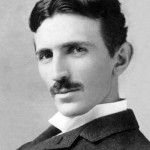 For months Tesla fought his own demons, both psychological and physiological. Convulsions periodically wracked his body and mental fatigue drained him of the will to live. On top of his ailments Tesla was also besieged with his continued failure to solve the problem of the commutatorless AC motor – a problem that had first become his obsession in Prof. Poeschl’s lecture hall back in Graz. Likely the pursuit of this solution was what kept him going.
For months Tesla fought his own demons, both psychological and physiological. Convulsions periodically wracked his body and mental fatigue drained him of the will to live. On top of his ailments Tesla was also besieged with his continued failure to solve the problem of the commutatorless AC motor – a problem that had first become his obsession in Prof. Poeschl’s lecture hall back in Graz. Likely the pursuit of this solution was what kept him going.
Part of his therapy, if you will, was to take daily walks, something that his friend Anton Szigeti had insisted upon. It was during one of these walks that Tesla was to make the discovery that would change his life and eventually put the world on the path to modern electricity. In 1882, Budapest was less than a decade past the official merging of the twin capital cities of Buda and Pest, along with Obuda (ancient Buda). Construction of the now imposing parliament building that dominates the Pest side of the Danube River wouldn’t be started for another three years, while high on the hill of the opposite bank the centuries-old Buda Castle was undergoing yet another remodeling as the city grew to accommodate its new role in the autonomous Hungarian government. Electric lighting – by direct current – had been installed in the city center in 1878.
It was here that Tesla walked one evening with Szigeti as the sun slowly settled down over the horizon. The glistening sunset reminded Tesla of one of the many poems that he had memorized – from the tragic play Faust by the German writer and polymath Johann Wolfgang von Goethe. Tesla fell into a near trance as he recited aloud Goethe’s famous lines in its original German*:
“Sie ruckt und weicht, der Tag ist uberlebt,
Dort eilt sie hin und fordert neues Leben.
Oh, dass kein Flugel mich vom Boden hebt
Ihr nach und immer nach zu streben!Ein schoner Traum indessen sie entweicht,
Ach, zu des Geistes Flugeln wird so leicht
Kein korperlicher Flugel sich gesellen!”[The glow retreats, done is the day of toil;
It yonder hastes, new fields of life exploring;
Ah, that no wing can lift me from the soil
Upon its track to follow, follow soaring!A glorious dream! though now the glories fade.
Alas! the wings that lift the mind no aid
Of wings to lift the body can bequeath me.]
Tesla suddenly stopped. Then, as he relates in his autobiography:
“As I uttered these inspiring words the idea came like a flash of lightning and in an instant the truth was revealed. I drew with a stick on the sand the diagrams…The images I saw were wonderfully sharp and clear and had the solidity of metal and stone, so much so that I told him: ‘See my motor here; watch me reverse it.’ I cannot begin to describe my emotions. Pygmalion seeing his statue come to life could not have been more deeply moved. A thousand secrets of nature which I might have stumbled upon accidentally I would have given for that one which I had wrested from her against all odds and at the peril of my existence.”
The AC motor was invented, if only in his magnificently detailed mind’s eye. It would be another six years before Tesla, by then working in New York City, would be cajoled by Thomas Commerford Martin into presenting the design in an address to the American Institute of Electrical Engineers. For now the invention that would change the world remained in Tesla’s head, in such intense detail that for the next several years he modified and improved on the device entirely through visualization. As Tesla later describes in My Inventions:
“For a while I gave myself up entirely to the intense enjoyment of picturing machines and devising new forms. It was a mental state of happiness about as complete as I have ever known in life. Ideas came in an uninterrupted stream and the only difficulty I had was to hold them fast. The pieces of apparatus I conceived were to me absolutely real and tangible in every detail, even to the minute marks and signs of wear. I delighted in imagining the motors constantly running, for in this way they presented to mind’s eye a more fascinating sight. When natural inclination develops into a passionate desire, one advances towards his goal in seven-league boots. In less than two months I evolved virtually all the types of motors and modifications of the system which are now identified with my name.”
Still, it would be years later before his new invention would be actually put into use.
[Adapted from my book, Tesla: The Wizard of Electricity. For more, check out the links below]
****************
David J. Kent is the author of Tesla: The Wizard of Electricity and Edison: The Inventor of the Modern World (both Fall River Press). He has also written two e-books: Nikola Tesla: Renewable Energy Ahead of Its Time and Abraham Lincoln and Nikola Tesla: Connected by Fate. His next book, Lincoln: The Man Who Saved America, is scheduled for release in summer 2017.
Follow me by subscribing by email on the home page. And feel free to “Like” my Facebook author’s page and connect on LinkedIn. Share with your friends using the buttons below.










